Monday, August 29, 2022. When Memo said we had a chance to go on a jungle walk and then fish in a new place, we said “Sure!” What could go wrong?
Now, when Memo described the experience in front of us, he told us we’d get into the usual flat-bottom boat, go for a 20-minute ride, followed by a 30-minute walk through the jungle, where we’d take another boat to a lagoon. It turns out the boat ride to our jungle walk was a little longer than that, and the walk was much longer than what Memo had predicted, because Mark and I were curious about everything we saw.
The first thing I was curious about was the fact that Bismark was wearing rubber boots…even though it hadn’t rained since we arrived. That got me to thinking about snakes that slither on the ground. I also noticed the machete in his left hand. That got me thinking about mean, agressive snakes.
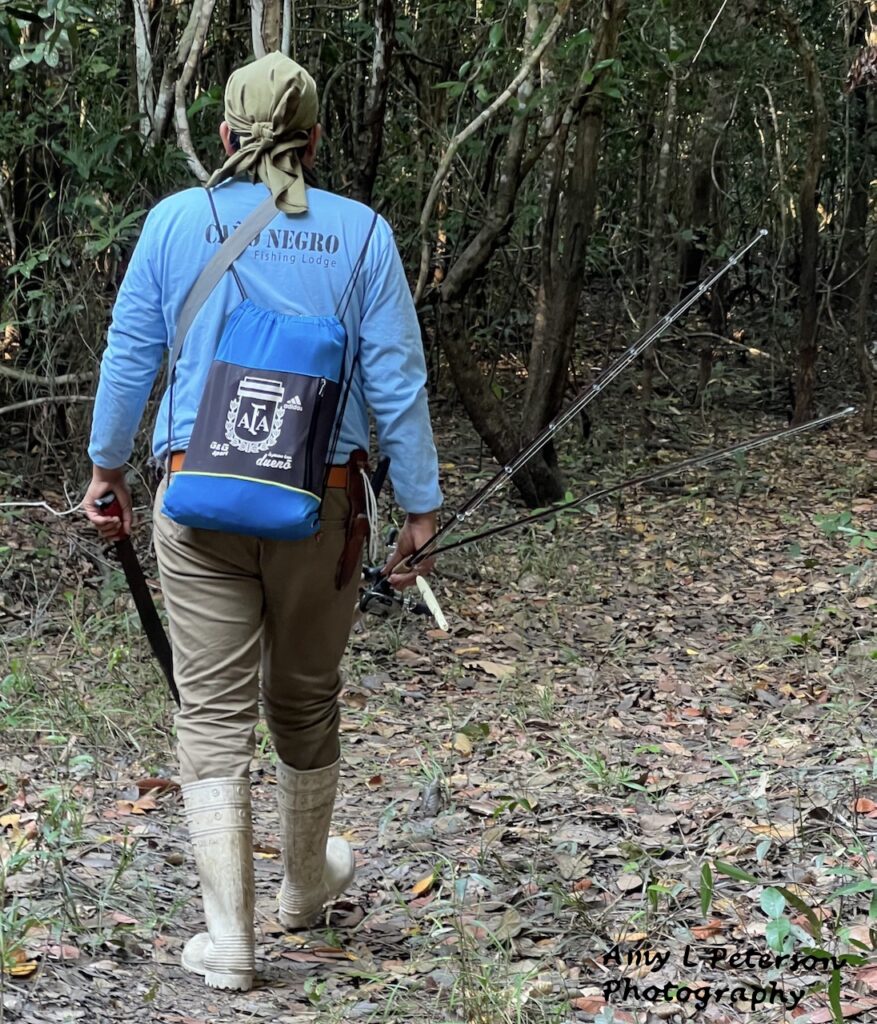
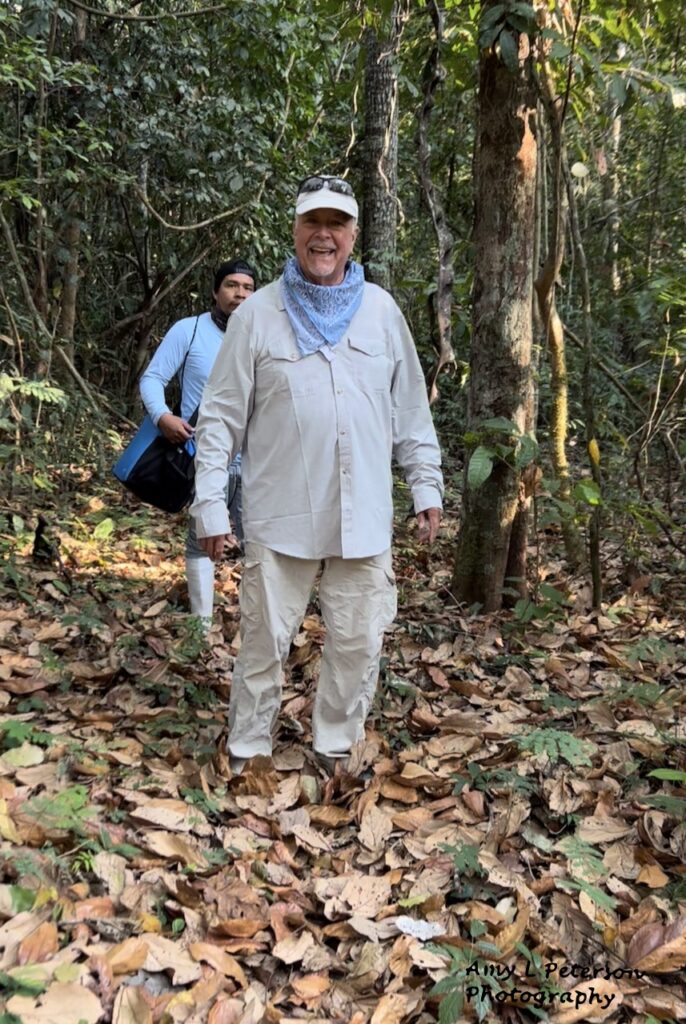
Raul–following behind Mark and me–also had on rubber boots and carried a machete. I had half a notion that this was a one-way walk…..
Now while Mark had a big smile on his face as he walked over the thick leaves and took in the scenery, Raul was not smiling because he had to wait for us as we stopped to pick up things, point things out, and take photos.
Raul was also perhaps less than cheery because he was carrying a black and blue soft-sided cooler loaded with water, pop and beer on ice. It was 8:00 in the morning. We’d be fishing until lunch. Since day one of our trip, Mark and I had had one beer during lunch one day. Mark told Raul some water and a single pop would do, that he could leave some of the beverages–including all of the beer–on the trail and we’d pick them up on the way back. Instead, Raul grunted and kept on walking. His dedication to make sure we had the best experience was amazing.
Bismark led the way down the path, whacking at veggies that might brush against us with his machete.
We stopped to shoot the tree to the right because we hadn’t seen this before. I don’t know what kind it is, so perhaps some day someone will see this page and tell me. The one below is also one we hadn’t seen before. I loved the rough bark…and half expected the tree to start talking.
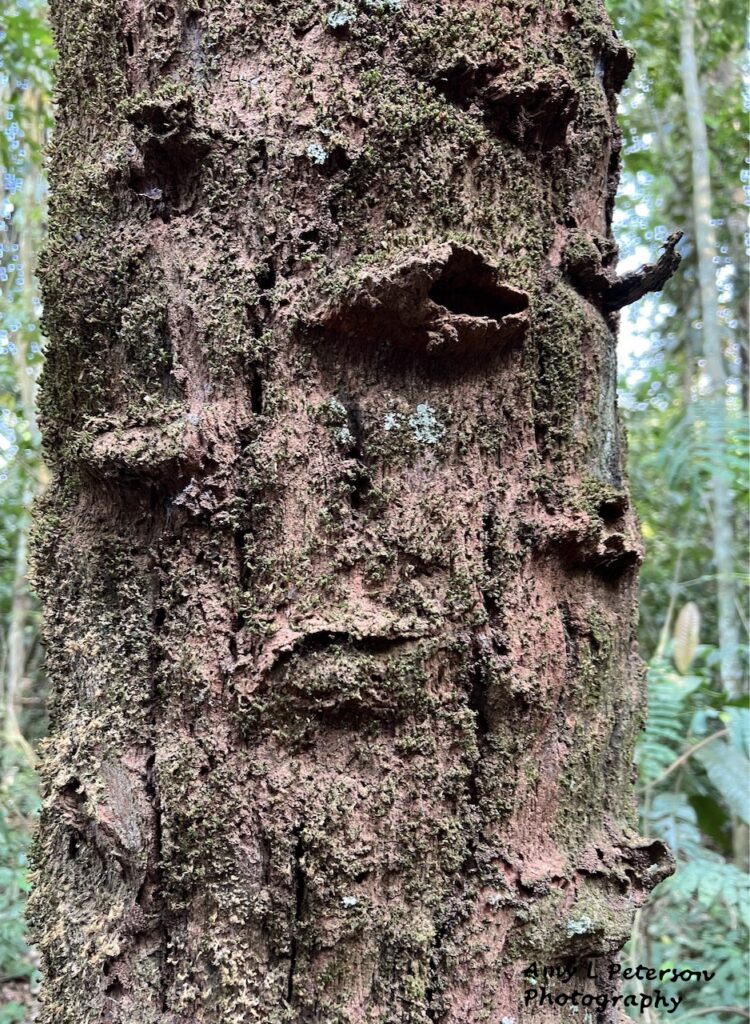
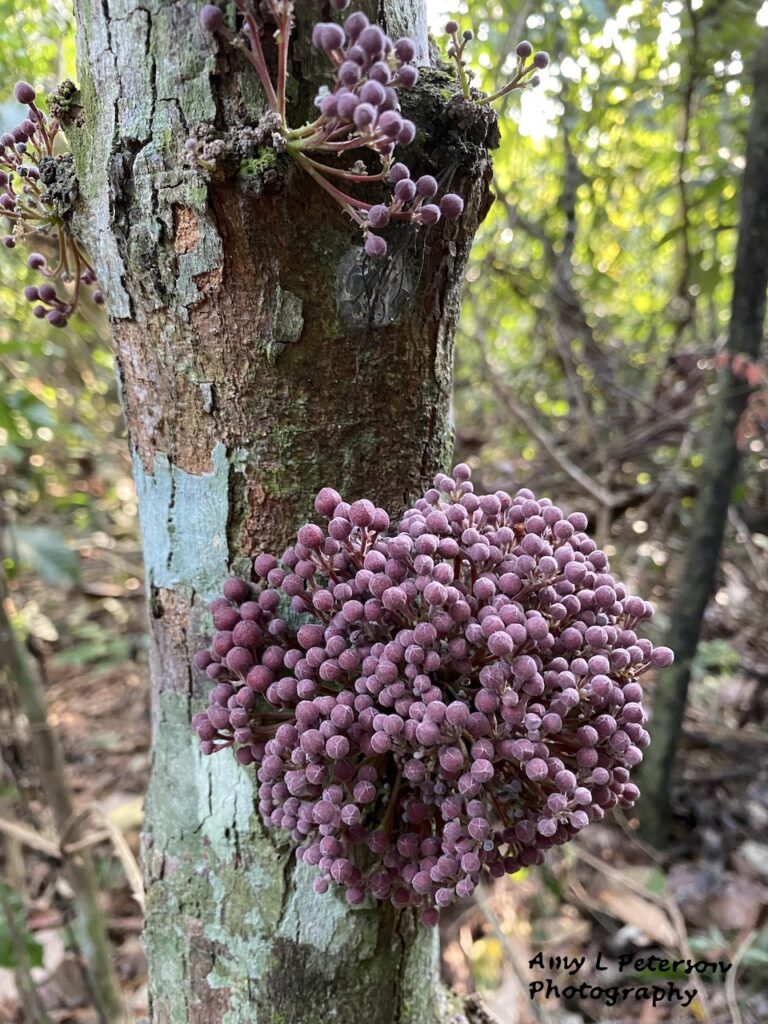
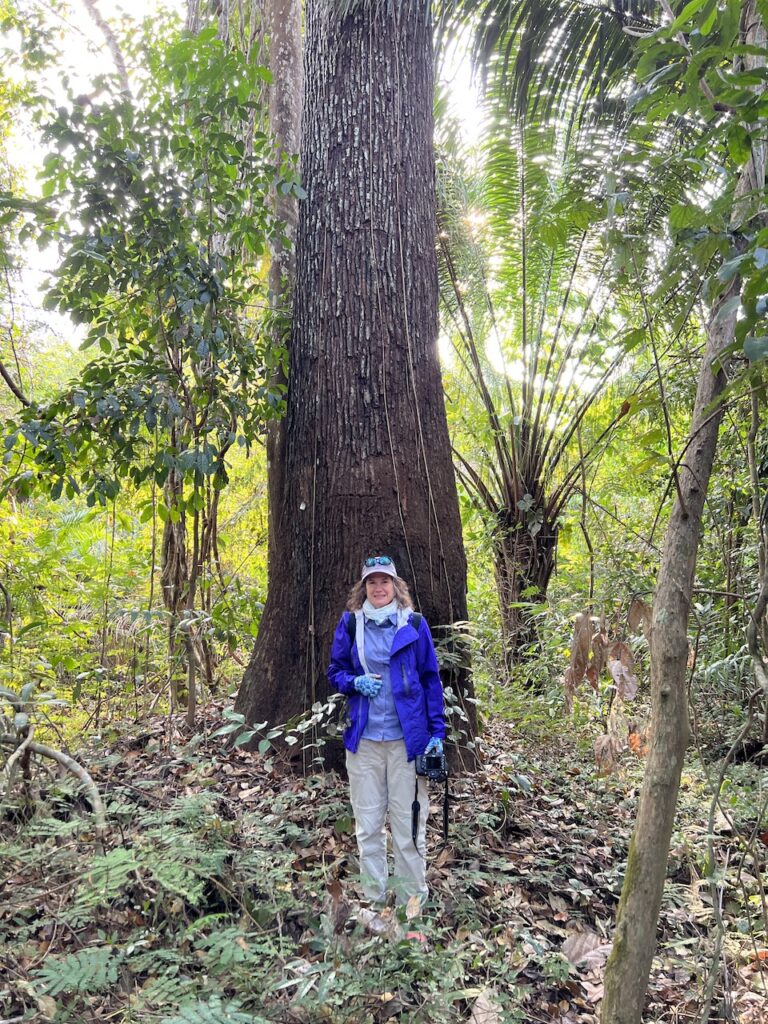
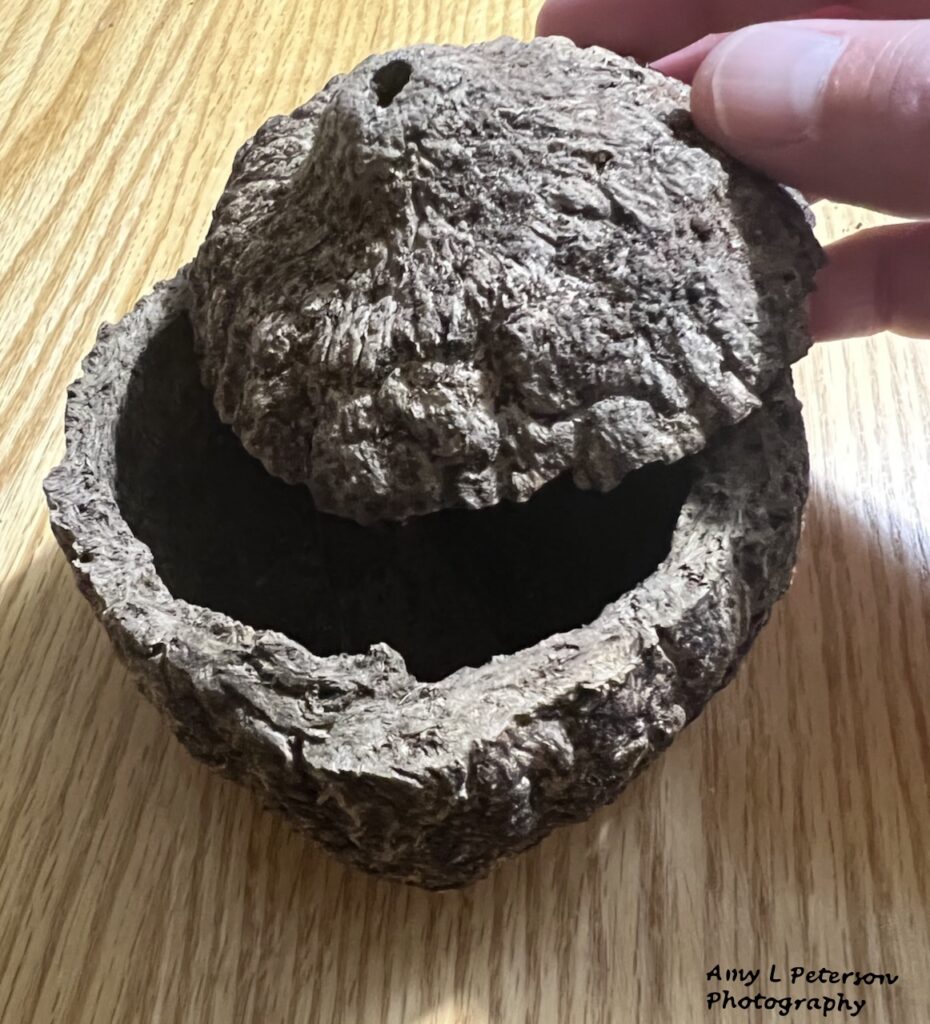
To the left is a nut under a Brazil nut tree. The photo above is the shell of a Brazil nut. The shell is about 1/4 of an inch think. And it’s super hard.

This tree put the jungle in perspective for me, because it looks like a vine tried to strangle this tree…which appears to be biting the vine. I find the jungle to be quite awesome when even the veggies are going for each other.
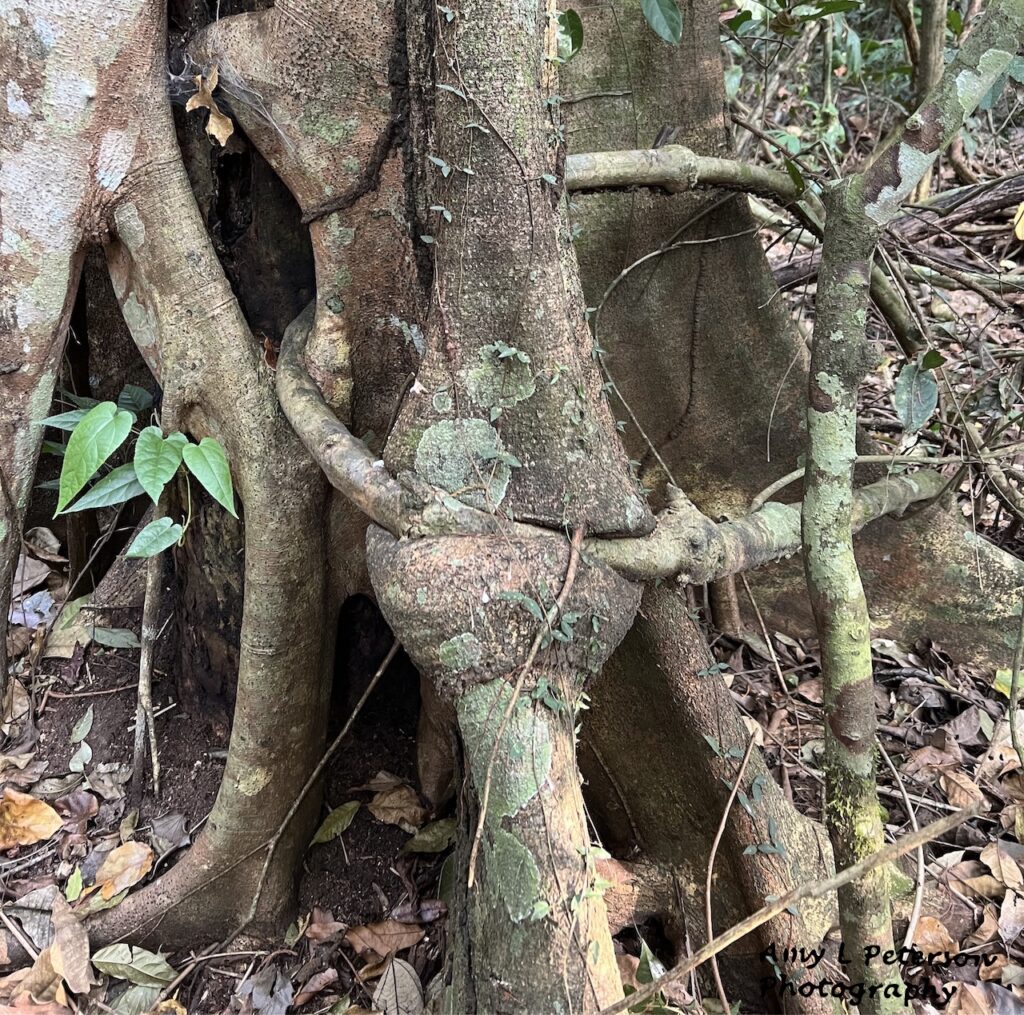

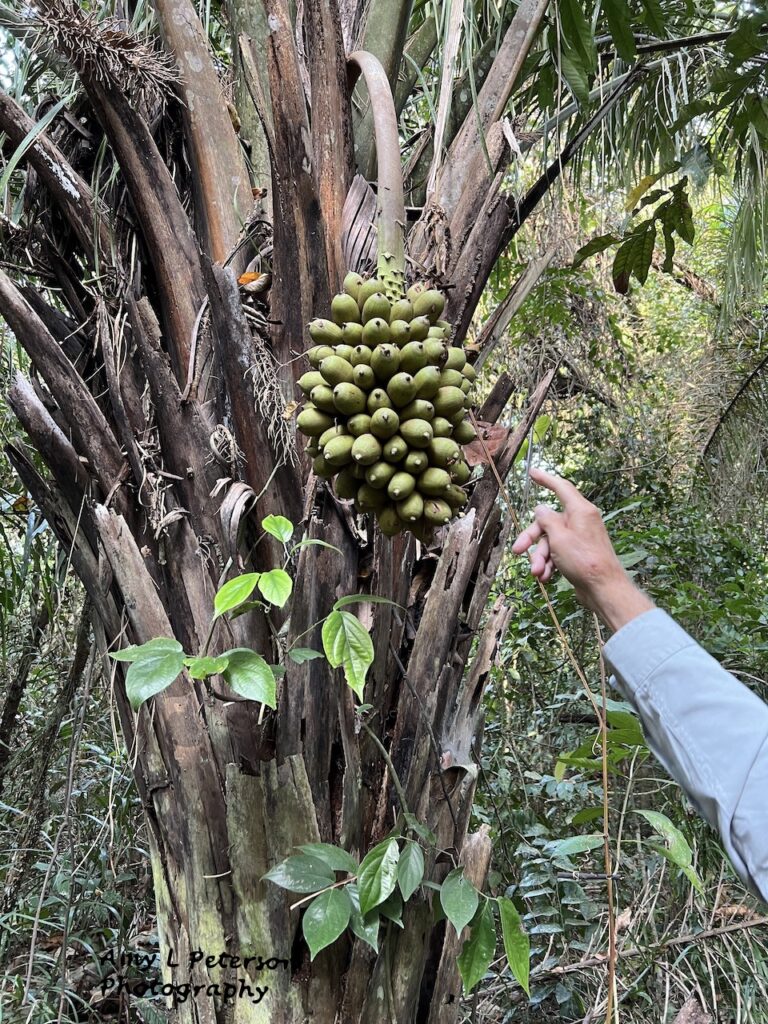
This is a palm tree that caught our attention.

Note the plastic chairs. They were at the launch spot.
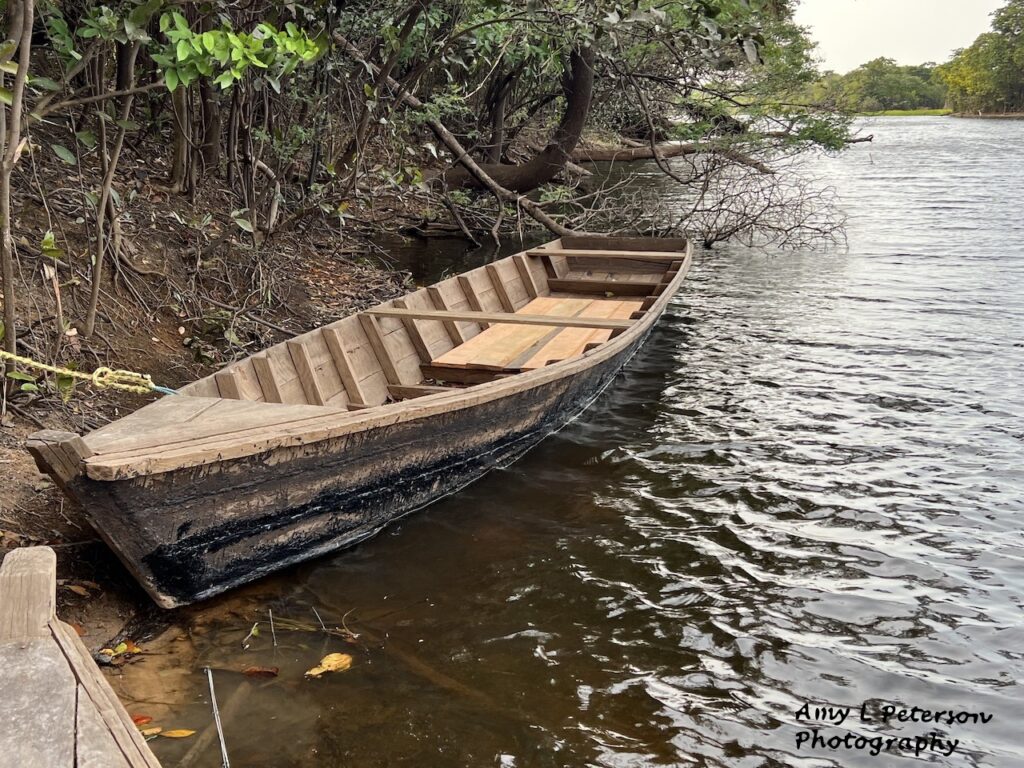
When we reached another river, a boat awaited us, just like Memo promised. It was a wooden boat, tarred on the side. I wondered how old the boat was. Nearby was another one I got a better photo of.
We soon discovered one reason the guides wore boots–the wooden boat leaked. But no worries, the guides had plastic bailers.
Mark and I settled into the chairs and the two guides sat in the back next to each other and paddled. At least Bismark was excited about it.
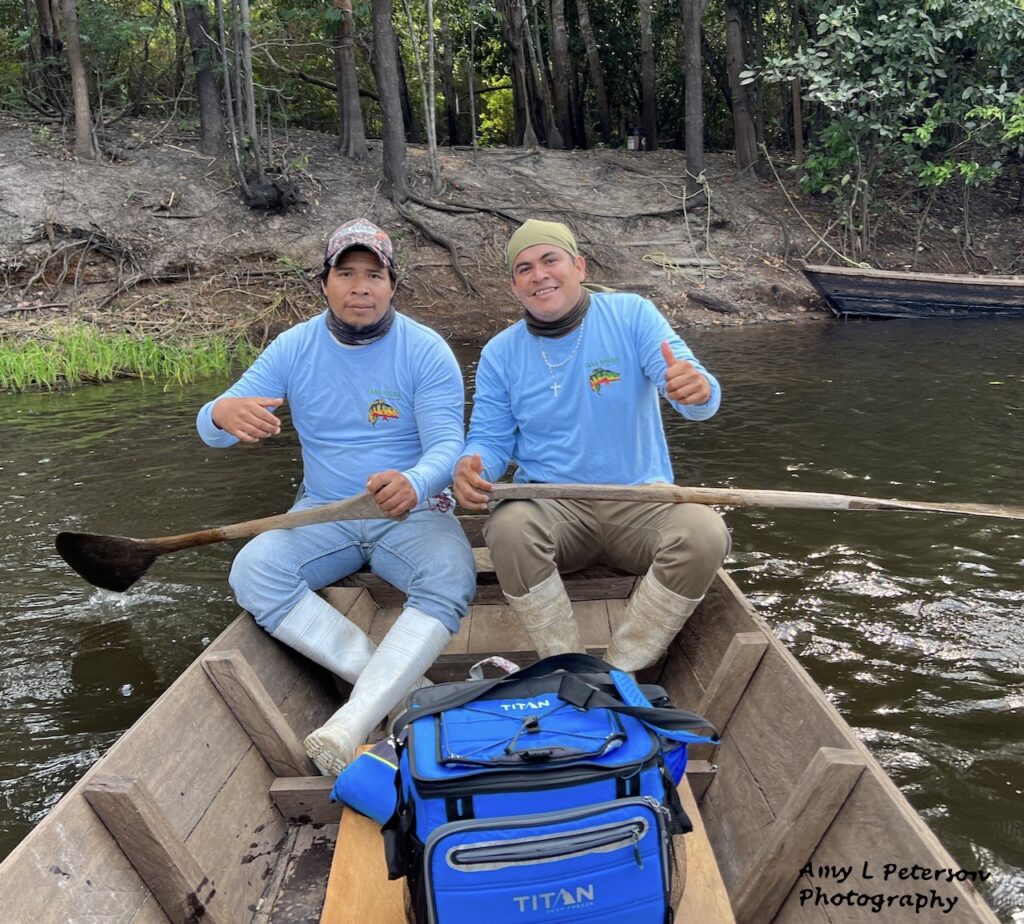
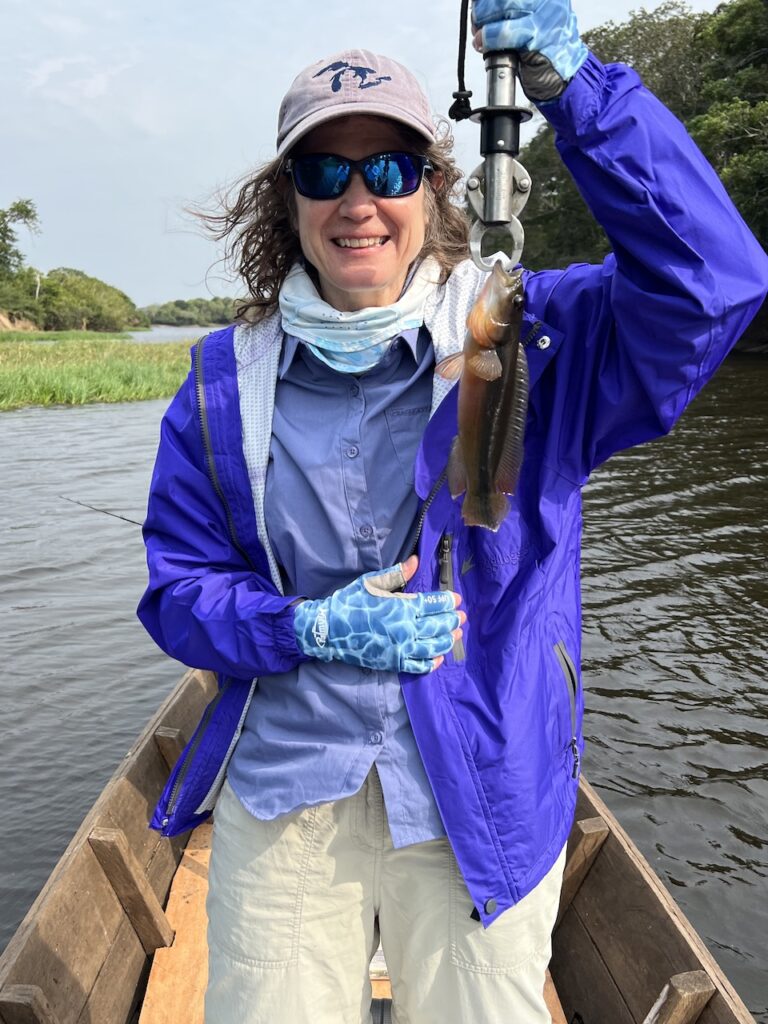
We started out in a stretch of river that resulted in a few catches, including this tiny jacunda. It was the smallest jacunda I’d ever caught. I was happy with my little fish pal, and also happy that the boat was steady enough to stand up in.
In the background is where we were heading. From here, it looked friendly enough.
The river led to a lagoon, and the first thing I noticed were tree trunks everywhere in the water and caiman everywhere on land, including this giant. Both the tree trunks and caiman would have been okay had the wind not picked up and had we not gotten stuck on submerged logs. Like five times. Each time, Mark had to walk from the bow of the boat–around me–to get to the back of the boat so the guides could pry the boat off the stump. Meanwhile, water poured into the bottom of the boat, and at one point–as we turned perpendicular to the wind– water came over the side.
But no worries, the guides had rubber boots on…. and Bismarks’s bailing kept us afloat. And no worries about falling in–there were only a few (thousand?) piranhas, most of which were much bigger than the one shown here. And no worries about a creature willing to attack a lure as big as it is.
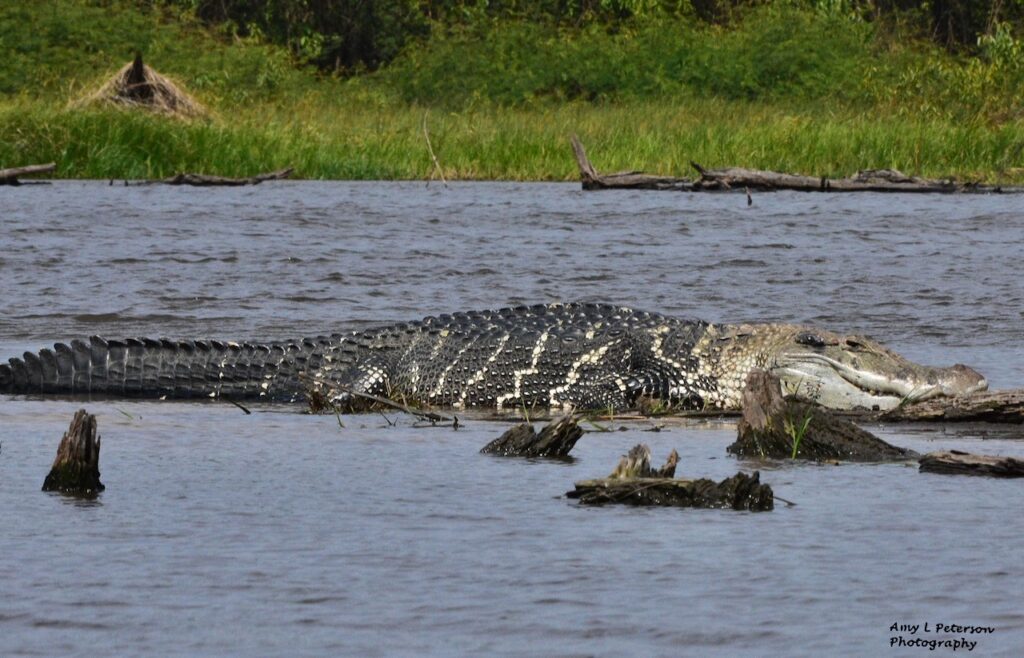
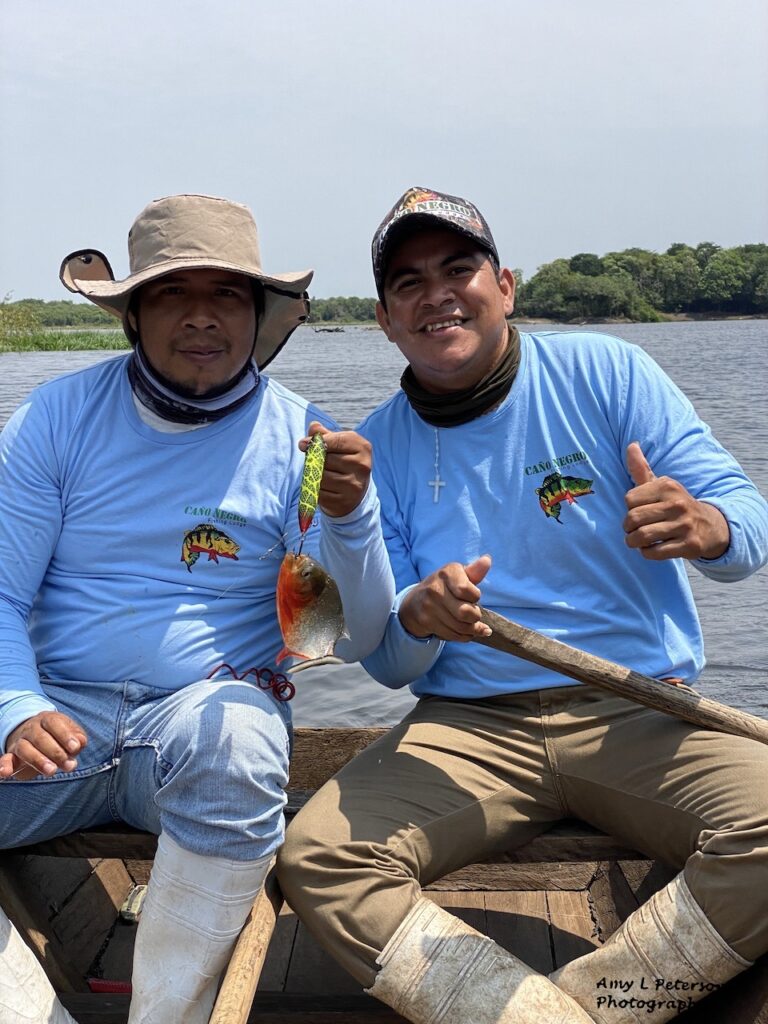

After we got stuck the third time, we realized that being up high in the chairs increased our instability. So we turned the chairs over and sat down on the wooden seats…which is kind of what Mark told Raul we were okay with doing to being with. (Or at least I think that’s what he suggested in Spanish.)
This photo gives a small hint at how unnerving this was, as the guides paddled with everything they had to fight the wind. Note the dry bag by my feet–I kept my camera and phone protected until we reached a sand bar. I never did get a shot of Mark sitting near the guides in the stern of the boat, because each time we got stuck, I put my phone and camera into the dry bag, just in case we tipped over.
When we pulled over onto a sand bar I was able to photograph this bird, which is a bare-faced ibis, named because they have no feathers on their faces.
Seeing this bird standing in the water made me realize how shallow some of the lagoon is. And if this bird could stand in the water and not get eaten, I was probably overly worried.
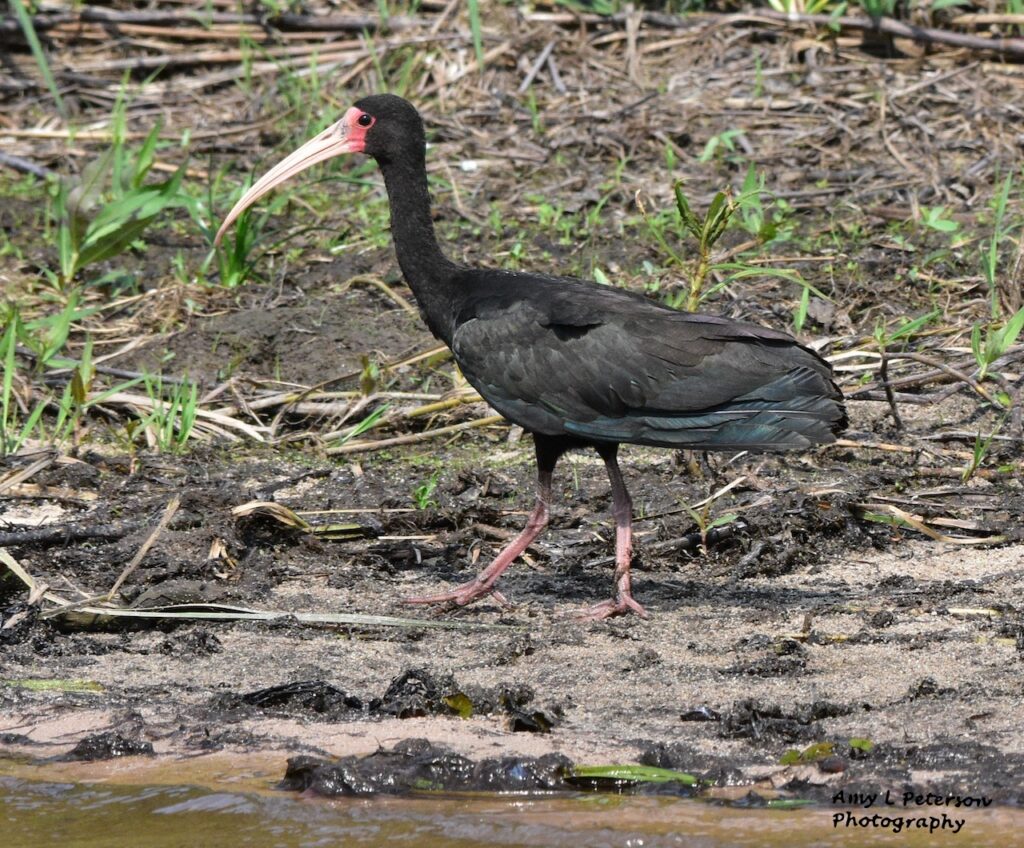

To the left is another bare-faced ibis, in this case, sporting more green feathers.
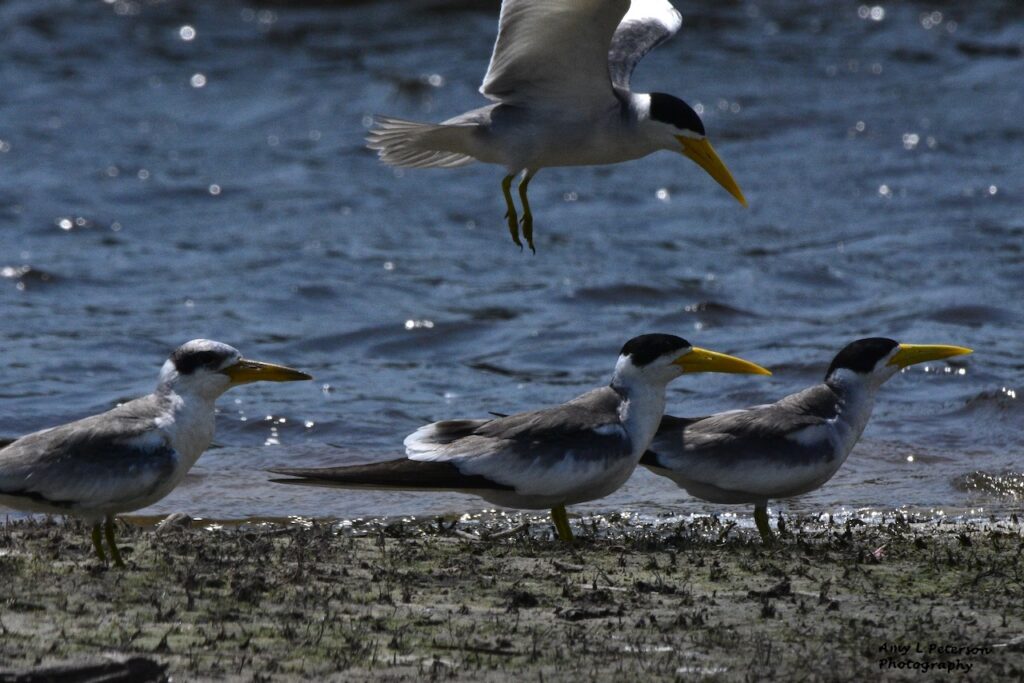
Off in the distance in a tree was a black-backed water tyrant, shown to the right. I thought tyrant meant cruel and oppressive ruler, so wonder what this bird does when we’re not watching. We also saw a yellow-billed cardinal which I didn’t get a shot of.
Nearby were several large-billed terns (at left). These are native of South America but occasionally seen in the US.

Now, while I was feeling a little outside my comfort zone in a boat that wobbled every time we bumped into a stump, Mark was unconcerned by the wiggly boat and having to move to the back of the boat now and again. He was, as usual, razor-focused on fishing. At one point he had his line cut by a piranha, lost his leader and–he thought–his lure (a surface bait). But as Mark tied on a spinner bait (shown in the photo), Bismark saw Mark’s surface bait pop up on the water. While the guides paddled to get Mark’s lure, Mark used his spinner bait and kept on catching fish.
I’ll note here that you can’t take too many extra leaders with you on a trip like this. With every cast of his leaderless spinnerbait, Mark risked losing his spinnerbait.
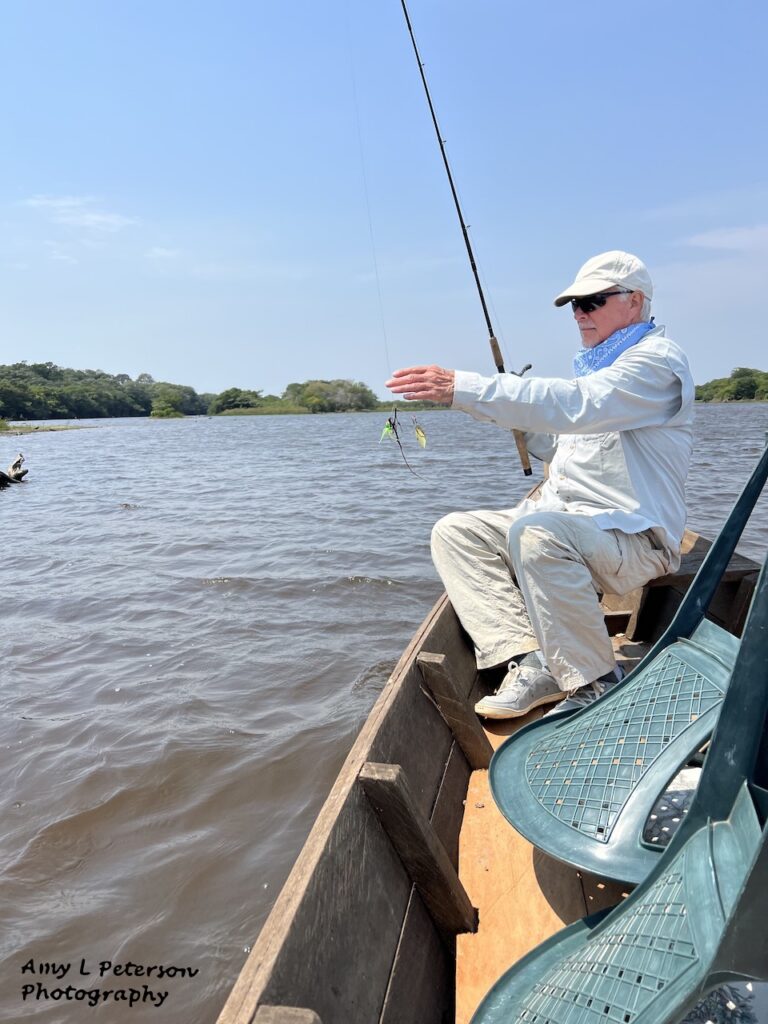
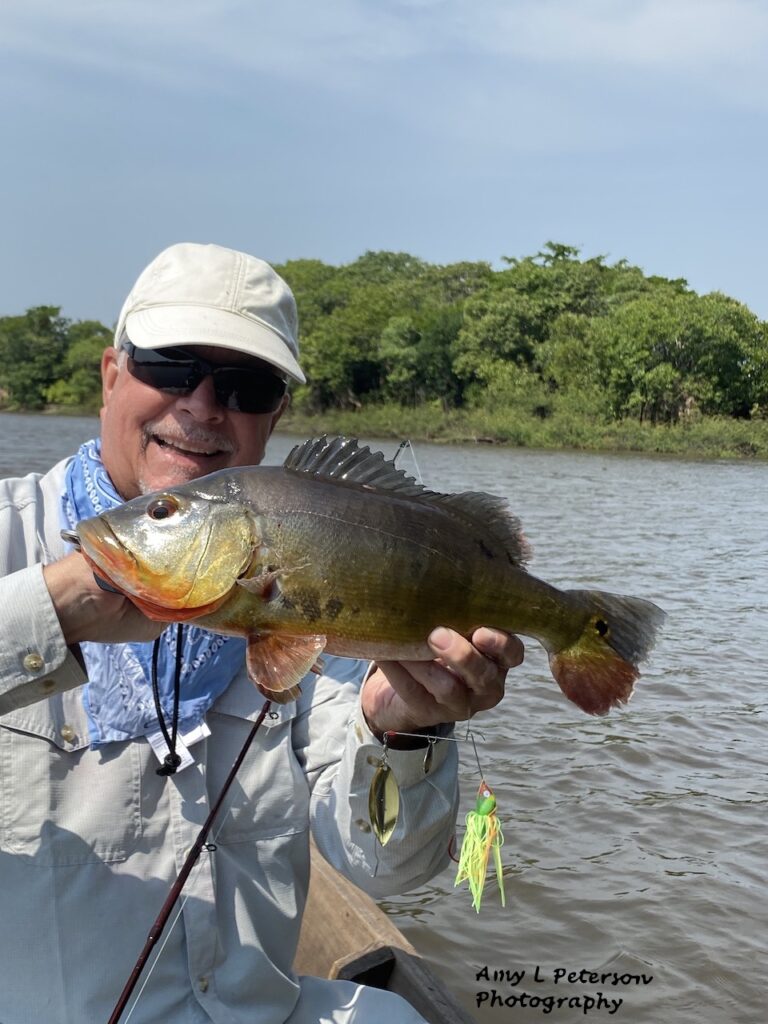
This is one of several peacock bass Mark caught with a spinnerbait. He also got half of a one-foot vampire fish–the other half was eaten off by a piranha before he got it into the boat. We removed the poor half-fish, tossed it back into the water and it was quickly eaten…based on the swirling in the murky water.
This photo shows more clearly the spinner bait Mark used to catch fish.
Before we reached shore again, we saw this pinnated bittern. From a distance it was very hard to see because it blended in so well with its surroundings. Even its feet blended into the log it was sitting on.
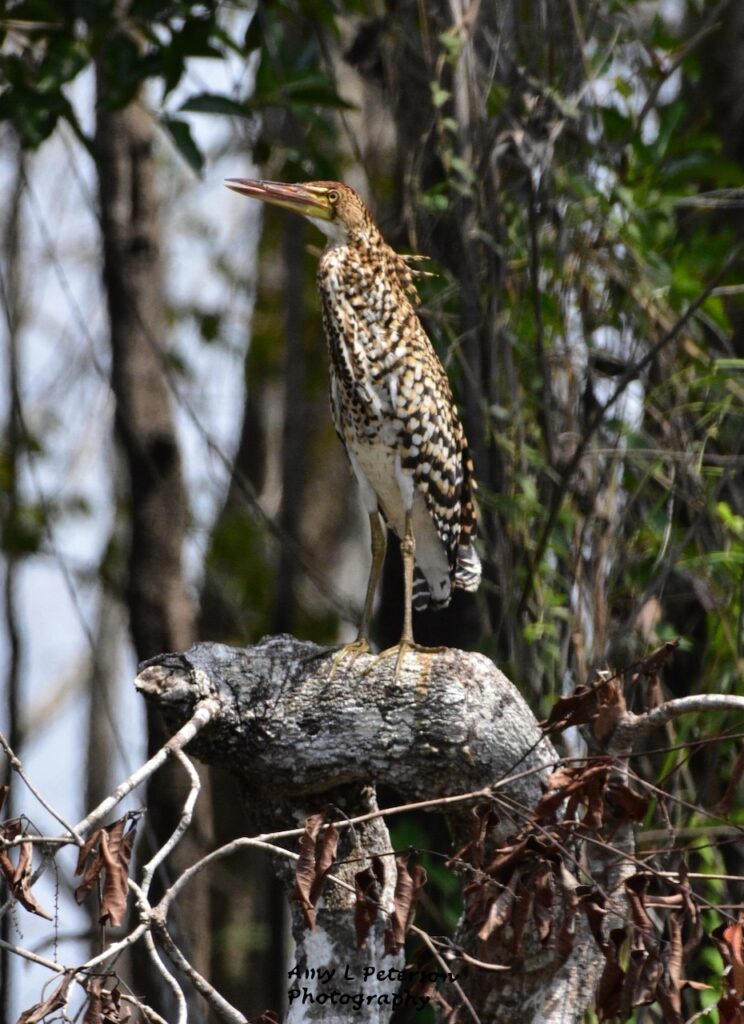
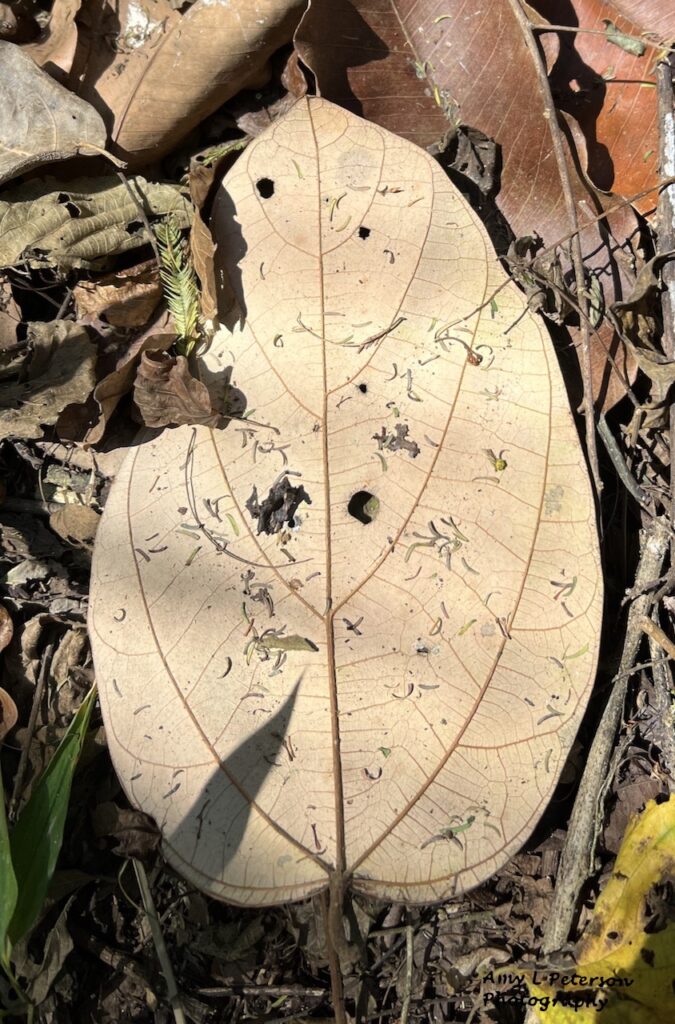
We returned to land and began our truck back through the jungle. We stopped only a few times for a few photos, mostly of seed pods.
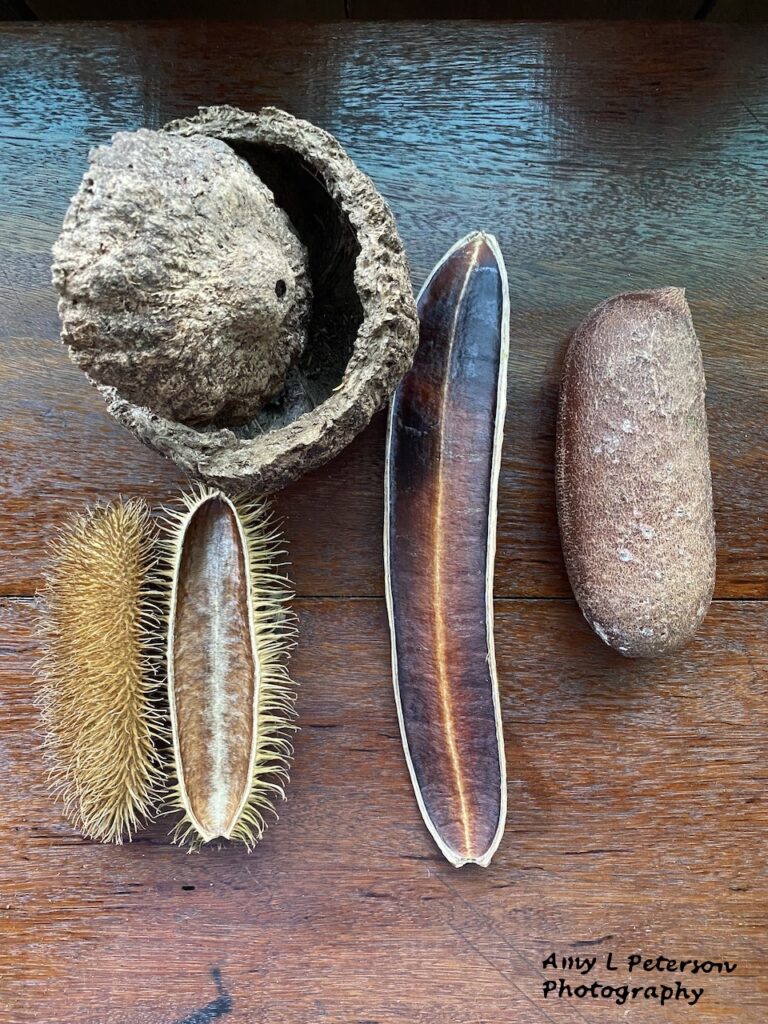
The most magical thing I saw on our way back–and perhaps the entire trip–was an eight-inch long insect that was black and blue and largely translucent, hovering like a helicopter with fairy-like wings near a tree. Mark said it was a blue-winged helicopter damselfly. I could not get my phone out fast enough to videotape it before it flew off. After the trip I didn’t find many videos online of blue-winged helicopter damselflies, and the photos I found were mostly of one of the damsels resting, which doesn’t do it justice. I can only say that I would go back to that place and wait for hours just for a chance to capture it on video.
As we were heading back to the lodge in our flat-bottom boat, another guide came toward us in a boat, apparently worried that we were late to return for lunch. It was after 1:00 after all. When we arrived, Memo’s wee frown made it clear he was not pleased. I told him taking two biologists in the jungle takes longer than he might think. Mark told Memo it was a bad idea to go to that lagoon on a windy day because guides couldn’t see stumps in the water. But we had survived and had f and seen lots of cool stuff.
We walked up to hill for lunch, likely leaving Memo scratching his head, wondering what to make of us.
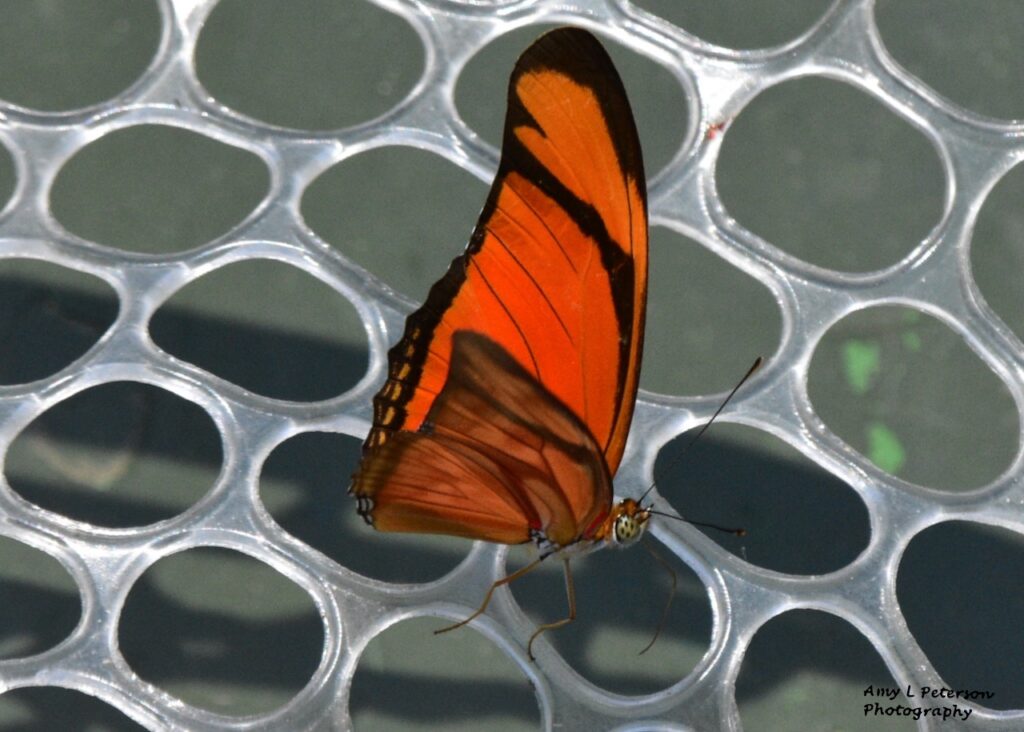
Once back at shore, I saw this butterfly on a landing net in one of the other boats.
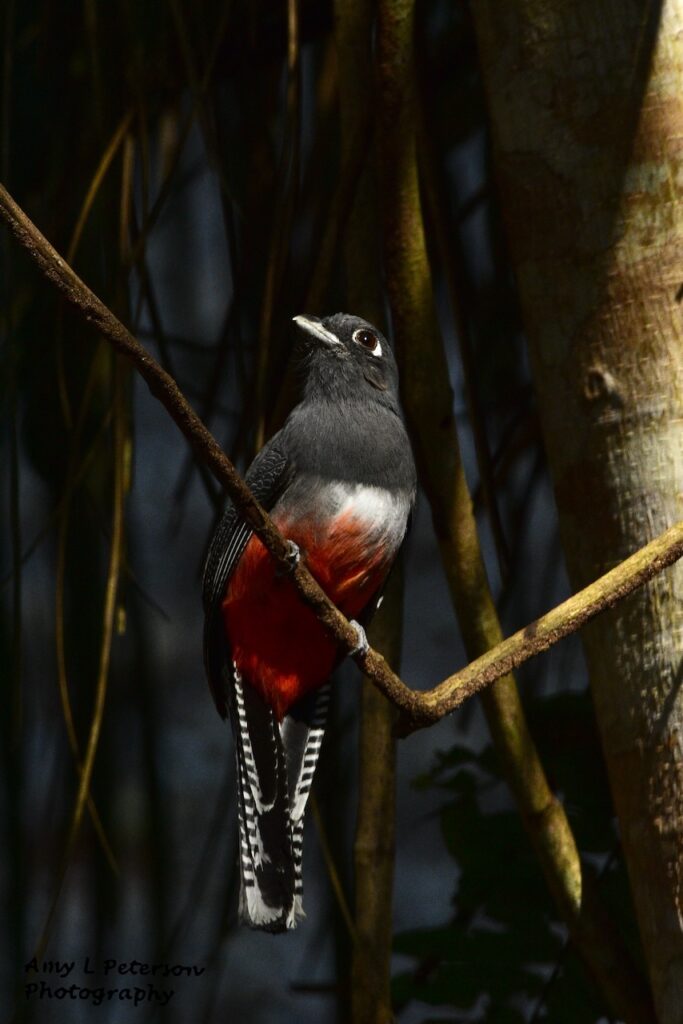
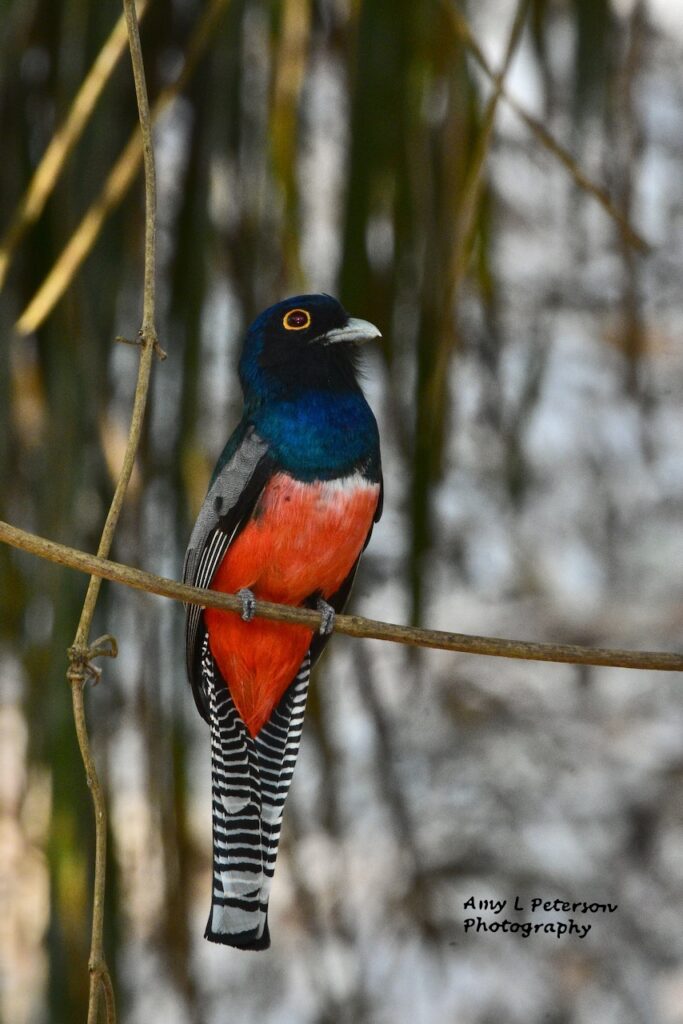
This is the male blue-crown trogon, perched near the female. He looked like he’d been skillfully painted by hand.
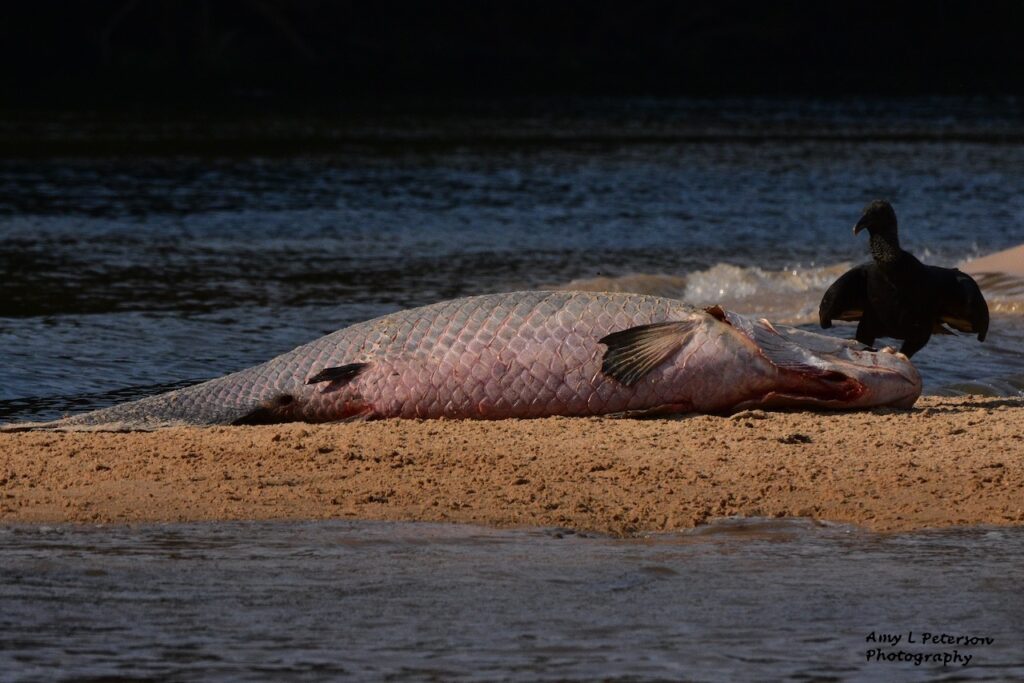
We fished upstream of this site for an hour, then worked out way back to this site again.
We anchored near a sand spit where two small caiman were sitting in the shallows within sight of the giant arapaima. As we fished, a large caiman came to shore, and for a moment I worried it was going to go after the two small caiman. But the large caiman swam by the little caiman, went downstream, pulled its massive body onto the shore, grabbed the giant arapaima, once, twice, three times to get a better grip, and, in front of a dozen disappointed vultures, took the big fish into the water and disappeared into the water downstream. It was really incredible to see a giant caiman with a giant fish just disappear in the water.


The rest of the afternoon was slow fishing until about 4:30. Suddenly, my line went zzzzzzzz and a big fish jumped out of the water, and we all went, “Arapaima.” I was using bass tackle, which means that my rod, line and leader were wimpy compared to the heavy rod we used for catfish. Considering that the largest peacock bass I had caught on this trip had busted a bass rod, I was a bit worried my arapaima would bust a rod, or the leader or the line.
Mark ran a video of my fish during one of several times it jumped out of the water. I estimated the fish to be perhaps 4 feet long. But we’ll never know for sure, because just as Raul was about to whack it over the head next to the boat, it busted the line and swam off.
I had hoped to get into the water with the fish and let it go. Instead, I apologized to the big fish and hoped it would somehow be able to get rid of the lure in its mouth.
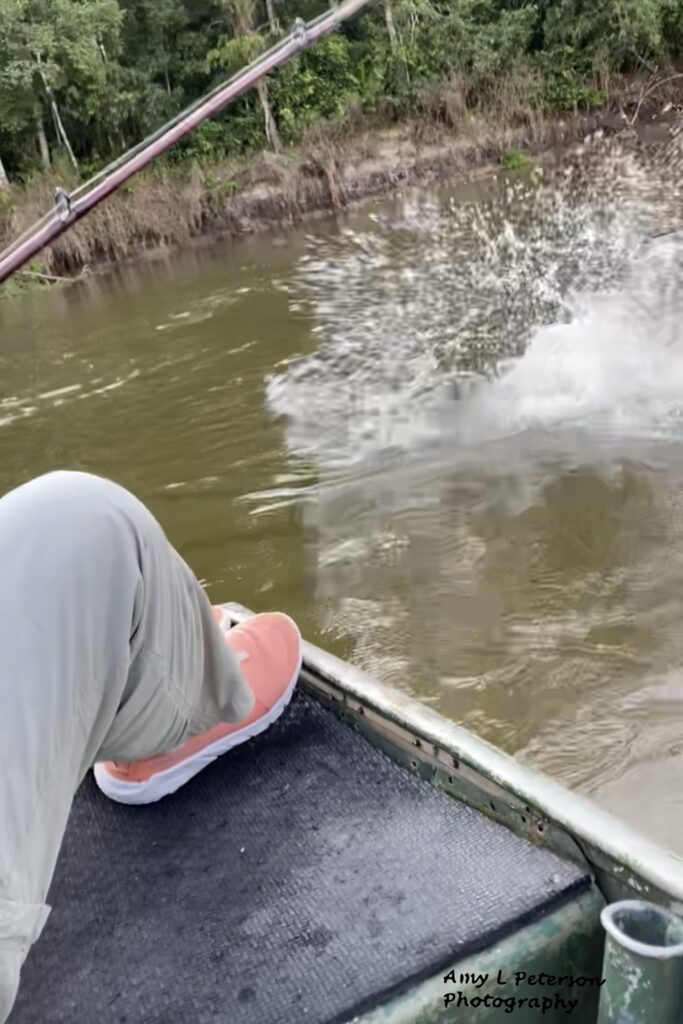
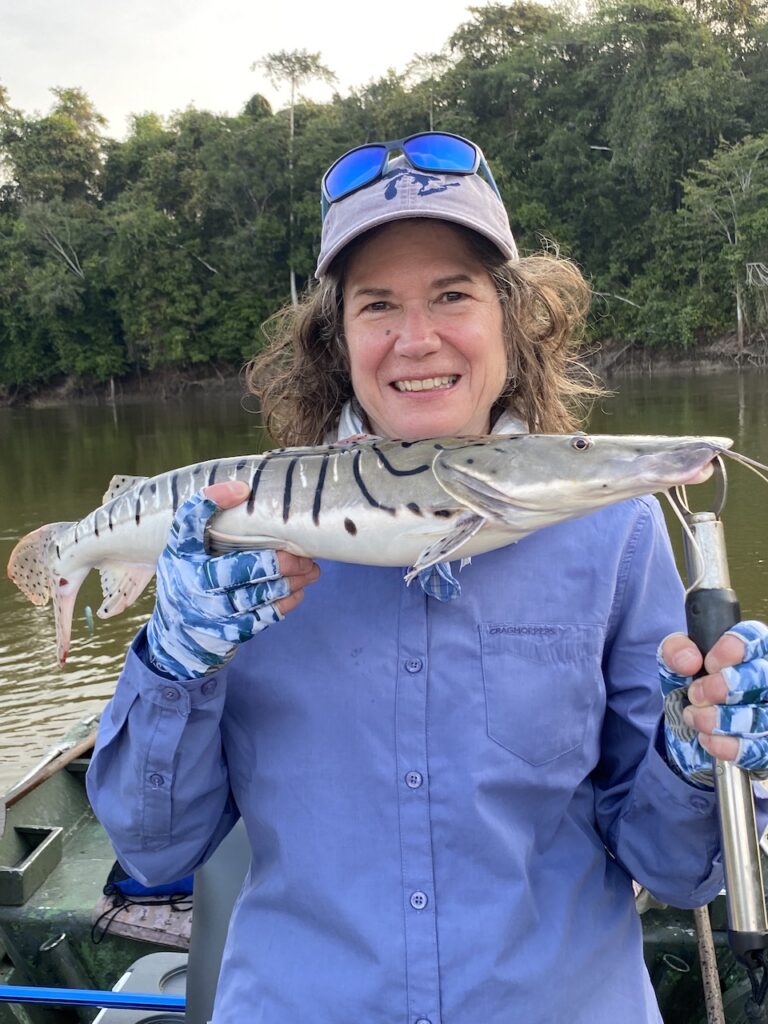
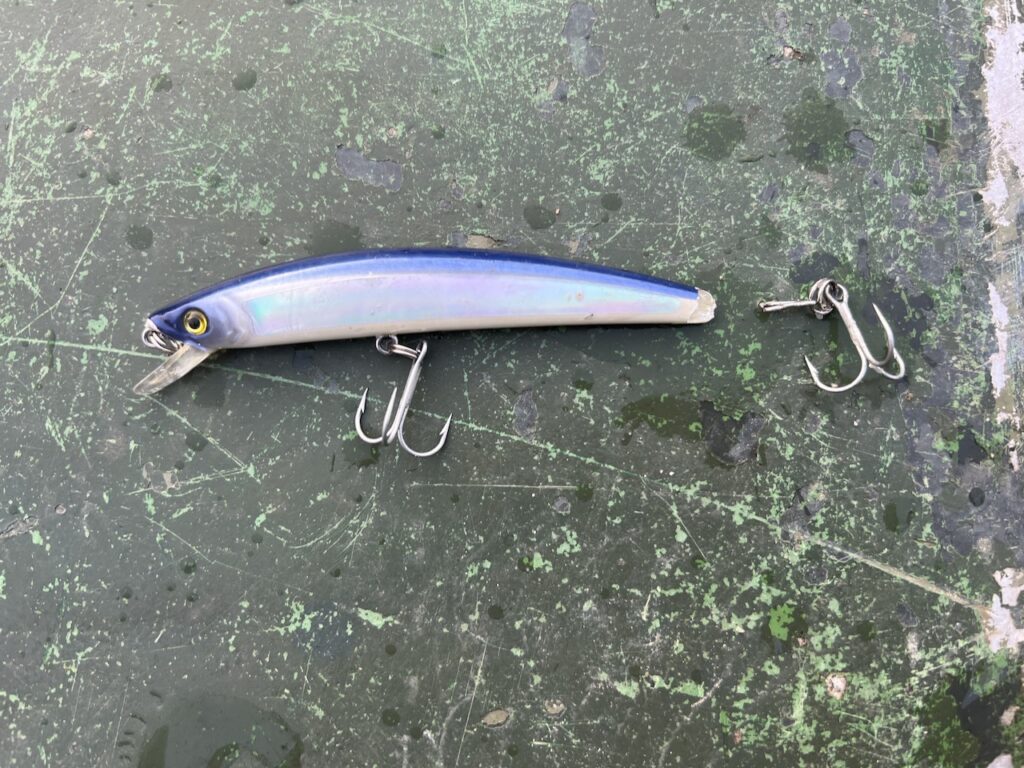
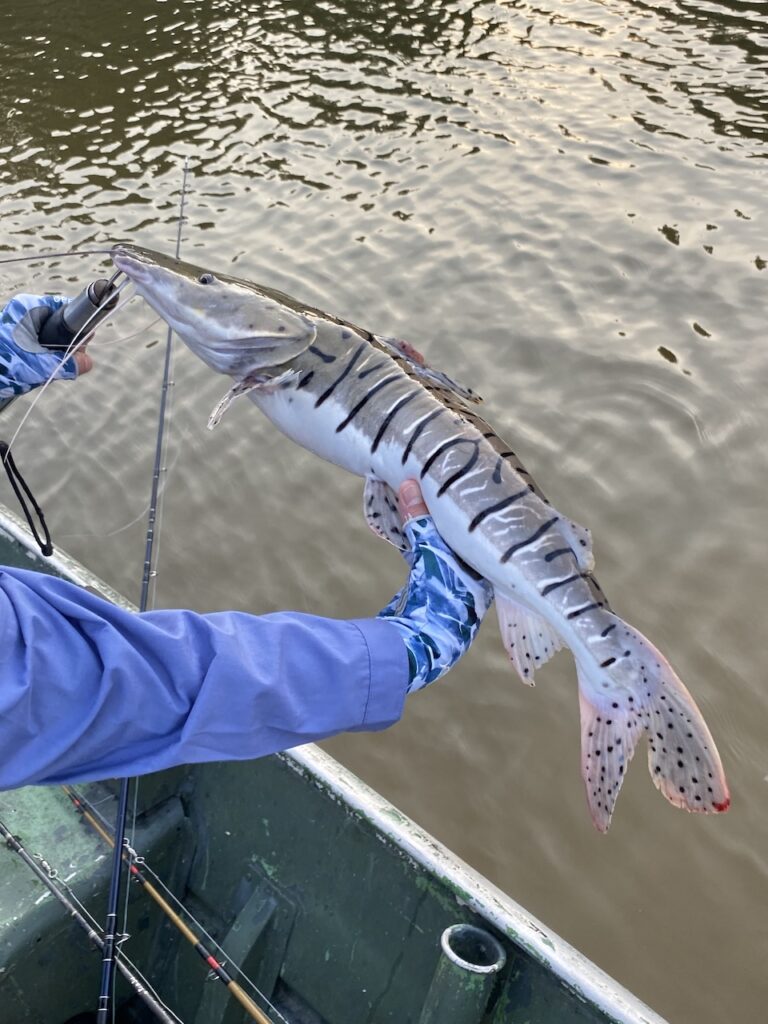
We moved again, and I landed a tiger shovelnose catfish, called locally, surubi (pronounced “sir-ooh-bee,” with the accent on the “bee”). This one busted my lure, though both pieces of the lure ended up getting caught in the net. I love the lines and dots on this fish.
One site online said surubi can live up to 25 years. We released all catfish.
Mark also got two doubles of piranhas, which is when two piranhas hit one lure at the same time. Those are aggressive fish in my books.
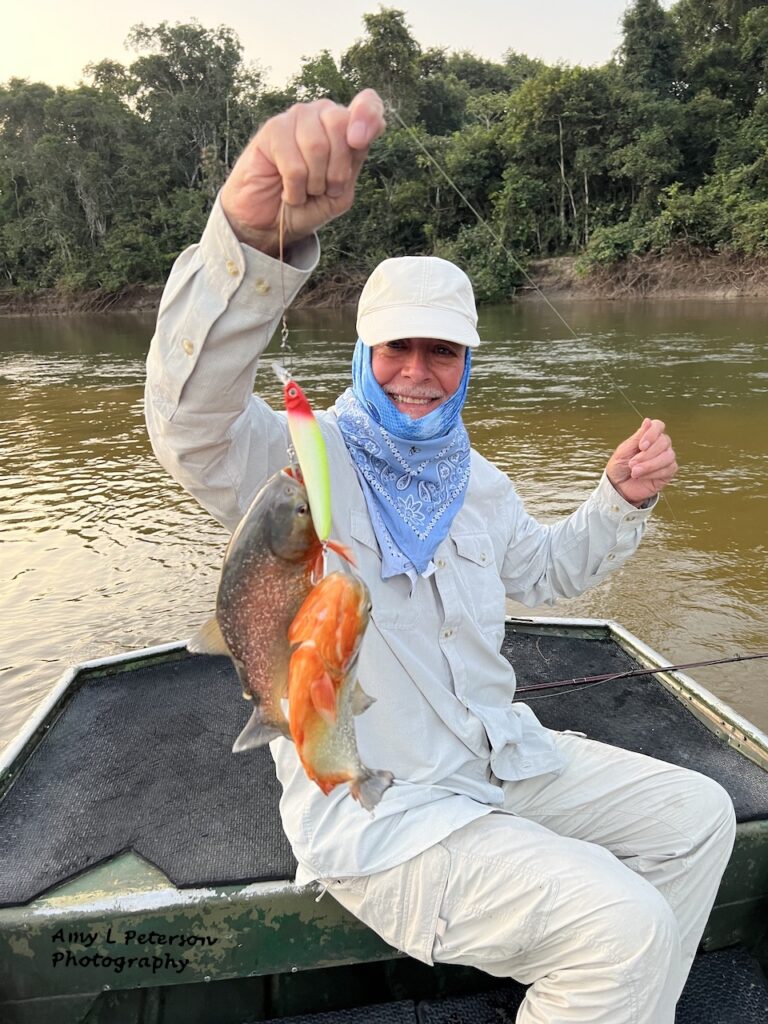
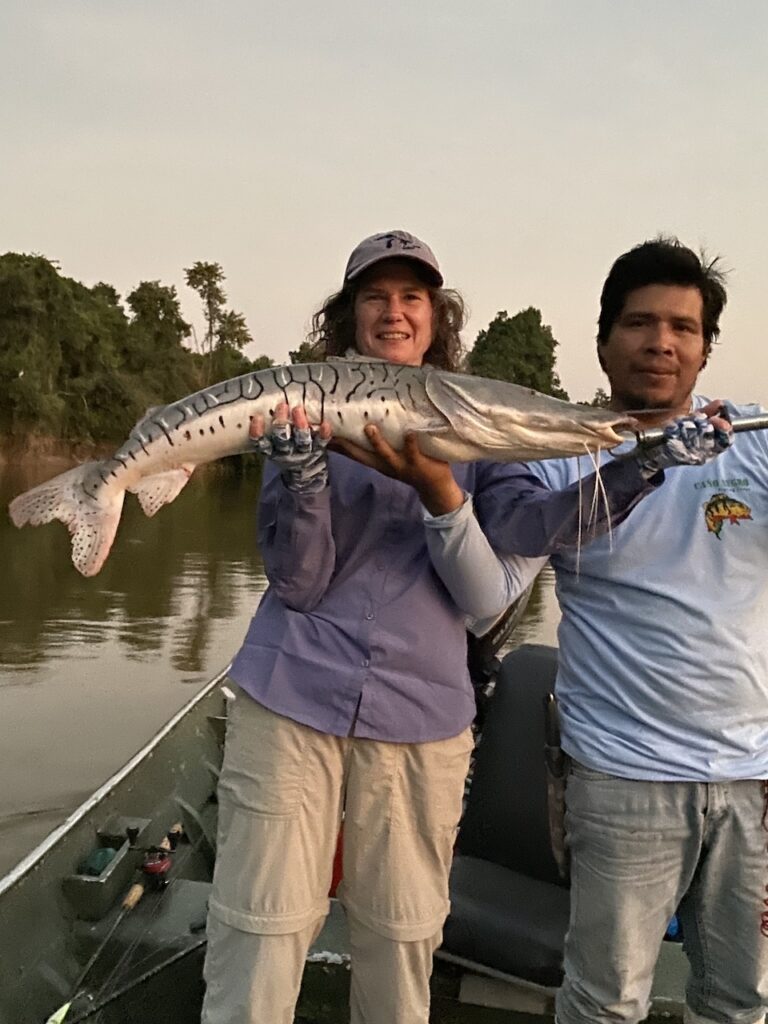
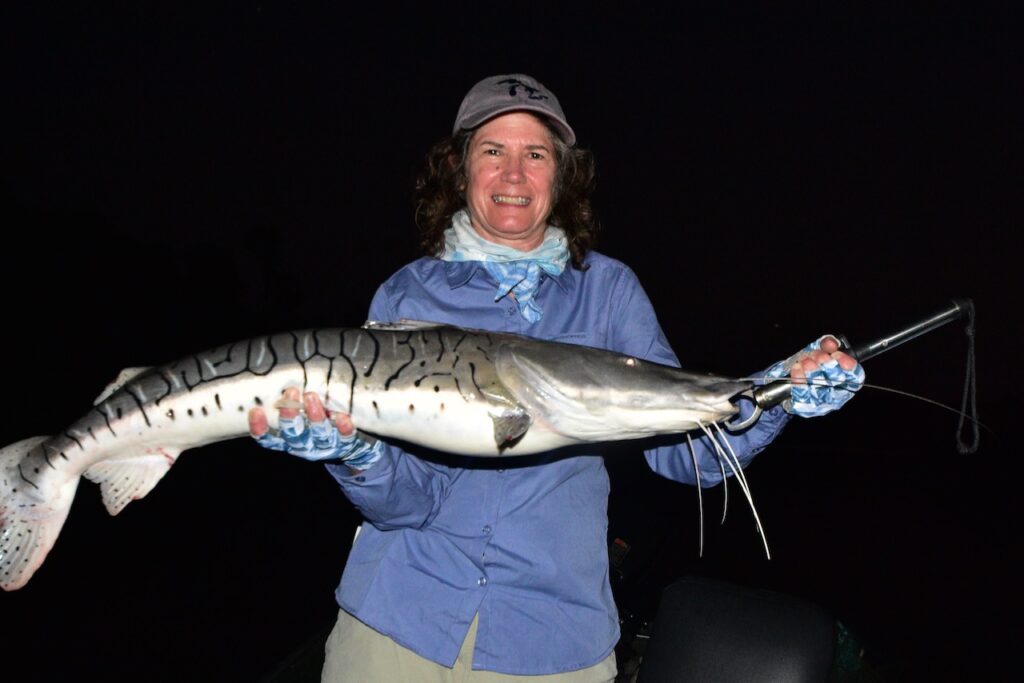
Meanwhile, I kept catching surubi and got to release a couple into the water. And I got to pose with our guide, Raul).
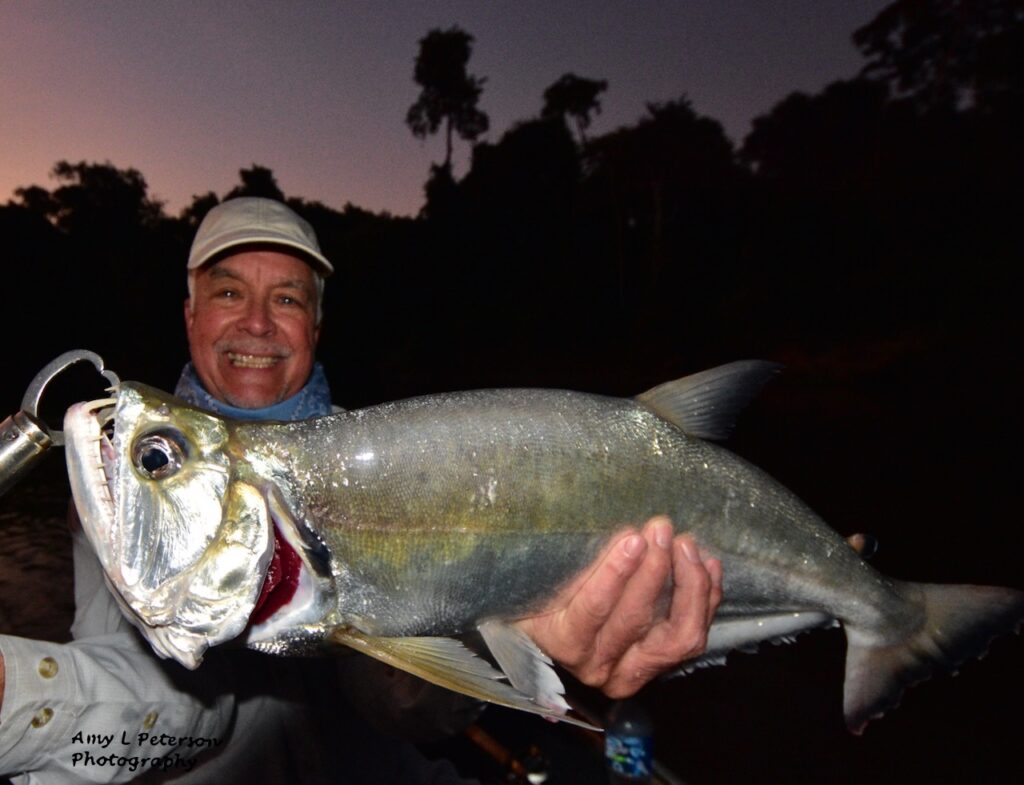
As the sun went down Mark caught this vampire fish. It was the first of two he caught casting a green fire tiger lure. At this point, Mark had caught 3 1/2 vampire fish. I had zero. I was super happy for him. And, being competitive, a little frustrated.
Vampire fish are also called payara, and their lower teeth disappear into holes in their upper jaw when they shut their mouth. They are such impressive fish. We released vampires, too.

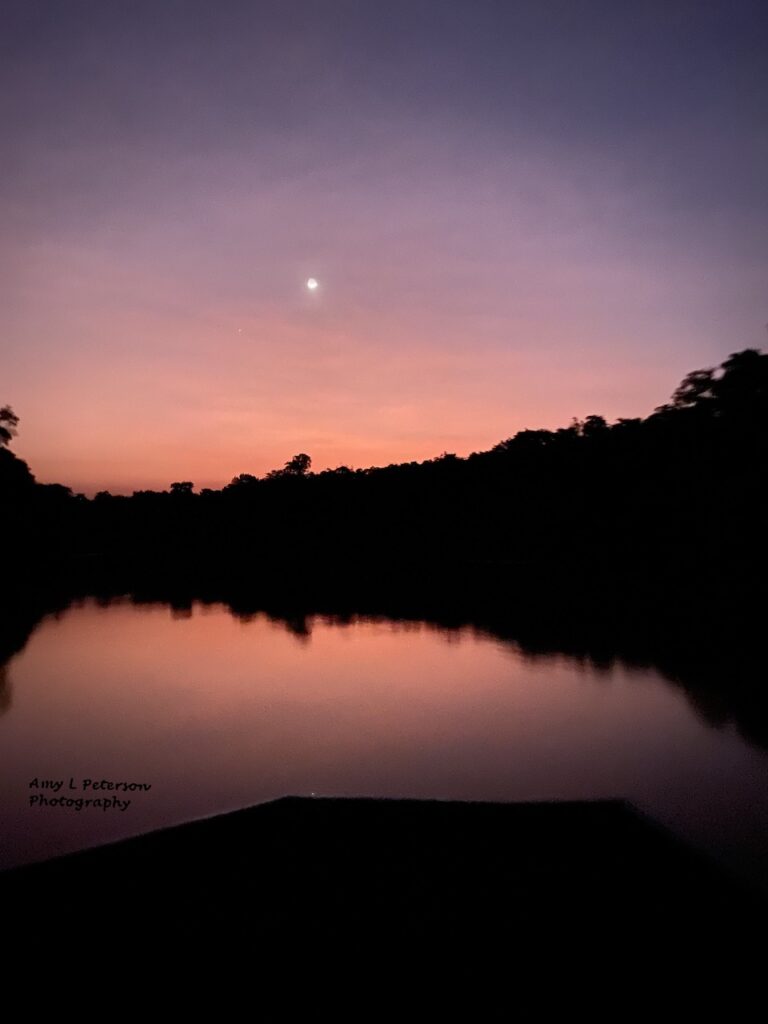
At home, I see sunsets out a bay window, but it’s a fleeting glimpse before I eat dinner, clean up after dinner, take care of the dogs and cat, work out or do some writing. In Bolivia, we had time to actually enjoy the sunset–watching as it went down and how colors changed and melted into darkness, as the frogs started calling some nights, strange birds called out, as the splashes of caiman were heard hither and yon down the river. We had gotten so used to the sounds, they were no longer scary, but instead, ones we looked forward to. Every night was a little different. Every night was amazing.

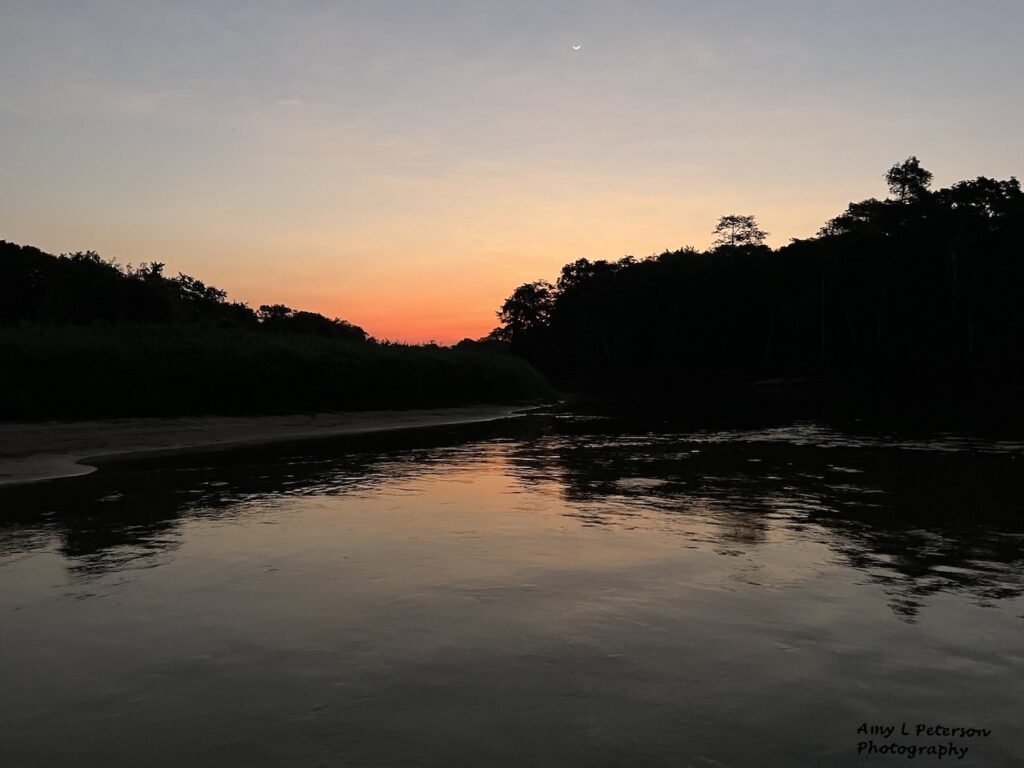
With the setting sun came cat fishing and more interesting night noises. Over the course of the next hour and a half we tried two different spots with no luck.
see video of the new night noises. We also saw a school of tiny fish in the water.
A few minutes after 8:00, my line went zzzzzz and I caught this retail catfish. We were close to shore and I asked if we could go to shore so I could walk the fish into the water. It all came together for me then–a woman from Michigan standing in the Amazon night with a creature I’d caught that looked like a giant golden tadpole. I stepped slowly into the water–because we had been warned that rays hunker down in the sand and ya don’t want to get nailed by a ray’s barb–and I walked out into the water far enough to lower the fish into the water. The fish turned toward the shore, I waved it toward the depths, it turned one more time and disappeared into the night. I gave Bismark and Raul a high five. It was one of the highlights of the trip for me. See the video.
It was 8:15 when Raul threw our lines out one more time. My line went zzzzzzz and zzzzzz and kept on going zzzzzzz. And going. I set the hook, tightened the drag and yet the line kept going. And then it stopped. And I could not reel anymore. A big fish rubbed had me off on a large deadfall way, way down the river. We pulled up anchor, went downstream, retrieved the hook and headed home.
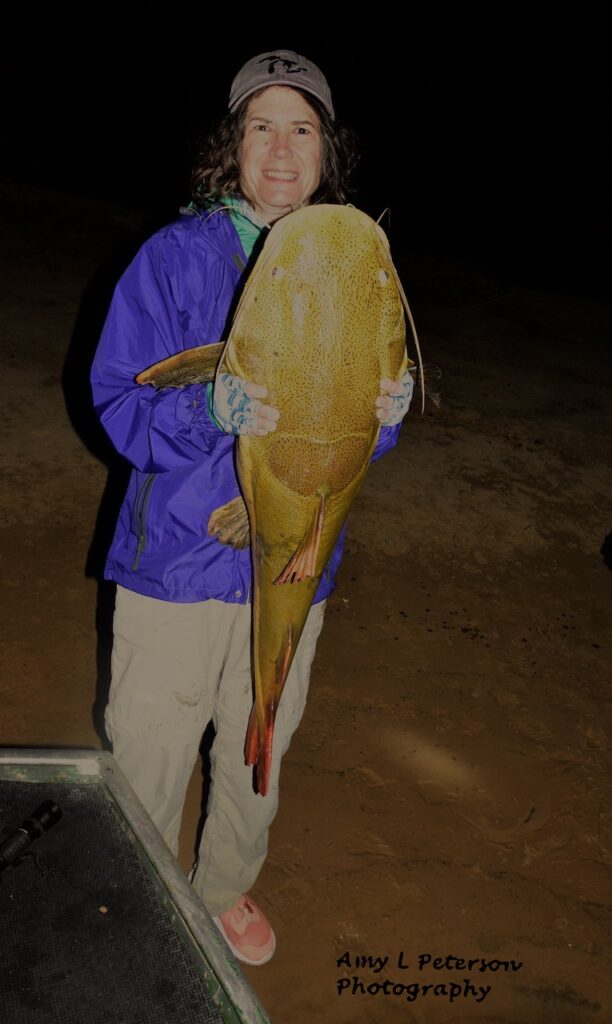
We didn’t get back until after 9:00…and Memo was not pleased, based on the wee frown on his face. I told him about letting a redtail go, and how a giant fish got on right at the end and how we’d had to retrieve the hook. Memo’s frown did not go away. John Jr and Drew were waiting near the shore with beers in hand, and as we walked up the hill to the lodge, John Jr said they were thinking about sending a boat out to look for us again. I said I liked being in trouble…and told him about the caiman eating the arapaima. He said it was his arapaima the caiman had pulled off the shore and into the water. He confirmed that after I showed him my video.

We headed to the lounge, and as we shared the tales of our afternoon, this female rhinoceros beetle flew into the open-air lodge and crash landed gracelessly on the floor. Mark picked it up, showed it around like he did the male, then took it out to the tree we’d released the male on.
The female was not keen on leaving Mark and she used her grappling hooks to hang onto his arm, and in the process, scratched up his hand. It took more than a few minutes to get her onto the palm tree, during which Mark swore more than once.
With our well-armored female rhinoceros beetle in the tree, we wandered off to bed.